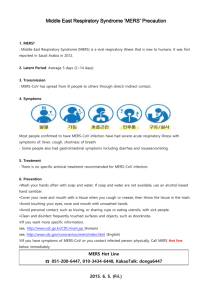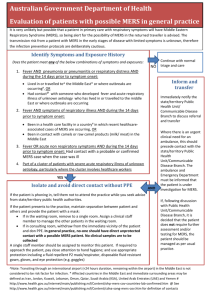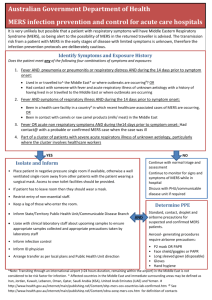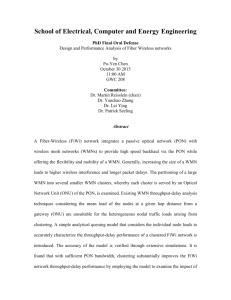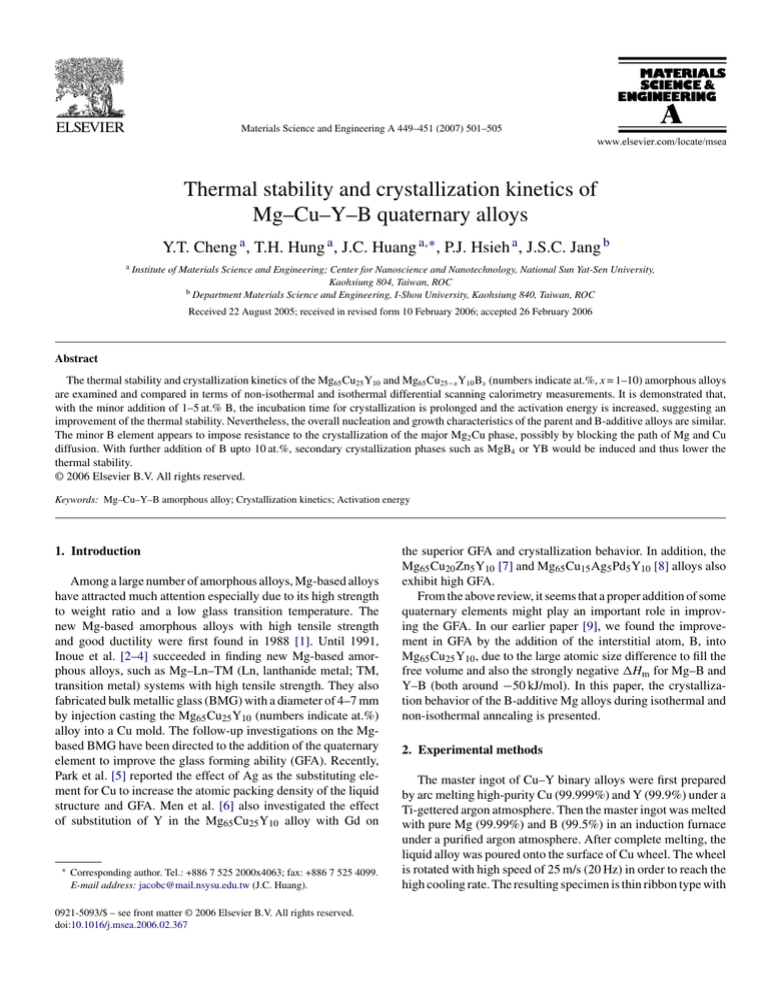
Materials Science and Engineering A 449–451 (2007) 501–505
Thermal stability and crystallization kinetics of
Mg–Cu–Y–B quaternary alloys
Y.T. Cheng a , T.H. Hung a , J.C. Huang a,∗ , P.J. Hsieh a , J.S.C. Jang b
a
Institute of Materials Science and Engineering; Center for Nanoscience and Nanotechnology, National Sun Yat-Sen University,
Kaohsiung 804, Taiwan, ROC
b Department Materials Science and Engineering, I-Shou University, Kaohsiung 840, Taiwan, ROC
Received 22 August 2005; received in revised form 10 February 2006; accepted 26 February 2006
Abstract
The thermal stability and crystallization kinetics of the Mg65 Cu25 Y10 and Mg65 Cu25−x Y10 Bx (numbers indicate at.%, x = 1–10) amorphous alloys
are examined and compared in terms of non-isothermal and isothermal differential scanning calorimetry measurements. It is demonstrated that,
with the minor addition of 1–5 at.% B, the incubation time for crystallization is prolonged and the activation energy is increased, suggesting an
improvement of the thermal stability. Nevertheless, the overall nucleation and growth characteristics of the parent and B-additive alloys are similar.
The minor B element appears to impose resistance to the crystallization of the major Mg2 Cu phase, possibly by blocking the path of Mg and Cu
diffusion. With further addition of B upto 10 at.%, secondary crystallization phases such as MgB4 or YB would be induced and thus lower the
thermal stability.
© 2006 Elsevier B.V. All rights reserved.
Keywords: Mg–Cu–Y–B amorphous alloy; Crystallization kinetics; Activation energy
1. Introduction
Among a large number of amorphous alloys, Mg-based alloys
have attracted much attention especially due to its high strength
to weight ratio and a low glass transition temperature. The
new Mg-based amorphous alloys with high tensile strength
and good ductility were first found in 1988 [1]. Until 1991,
Inoue et al. [2–4] succeeded in finding new Mg-based amorphous alloys, such as Mg–Ln–TM (Ln, lanthanide metal; TM,
transition metal) systems with high tensile strength. They also
fabricated bulk metallic glass (BMG) with a diameter of 4–7 mm
by injection casting the Mg65 Cu25 Y10 (numbers indicate at.%)
alloy into a Cu mold. The follow-up investigations on the Mgbased BMG have been directed to the addition of the quaternary
element to improve the glass forming ability (GFA). Recently,
Park et al. [5] reported the effect of Ag as the substituting element for Cu to increase the atomic packing density of the liquid
structure and GFA. Men et al. [6] also investigated the effect
of substitution of Y in the Mg65 Cu25 Y10 alloy with Gd on
∗
Corresponding author. Tel.: +886 7 525 2000x4063; fax: +886 7 525 4099.
E-mail address: jacobc@mail.nsysu.edu.tw (J.C. Huang).
0921-5093/$ – see front matter © 2006 Elsevier B.V. All rights reserved.
doi:10.1016/j.msea.2006.02.367
the superior GFA and crystallization behavior. In addition, the
Mg65 Cu20 Zn5 Y10 [7] and Mg65 Cu15 Ag5 Pd5 Y10 [8] alloys also
exhibit high GFA.
From the above review, it seems that a proper addition of some
quaternary elements might play an important role in improving the GFA. In our earlier paper [9], we found the improvement in GFA by the addition of the interstitial atom, B, into
Mg65 Cu25 Y10 , due to the large atomic size difference to fill the
free volume and also the strongly negative Hm for Mg–B and
Y–B (both around −50 kJ/mol). In this paper, the crystallization behavior of the B-additive Mg alloys during isothermal and
non-isothermal annealing is presented.
2. Experimental methods
The master ingot of Cu–Y binary alloys were first prepared
by arc melting high-purity Cu (99.999%) and Y (99.9%) under a
Ti-gettered argon atmosphere. Then the master ingot was melted
with pure Mg (99.99%) and B (99.5%) in an induction furnace
under a purified argon atmosphere. After complete melting, the
liquid alloy was poured onto the surface of Cu wheel. The wheel
is rotated with high speed of 25 m/s (20 Hz) in order to reach the
high cooling rate. The resulting specimen is thin ribbon type with
502
Y.T. Cheng et al. / Materials Science and Engineering A 449–451 (2007) 501–505
∼10 mm in width and ∼100 m in thickness. Thermal analysis
was carried out using differential scanning calorimetry (DSC)
under flowing argon atmosphere from 303 to 900 K. The specimens were placed in stainless steel crucibles and tightly sealed
with a Ni ring, and heated with positive Ar atmosphere. Heating
rates of 10–40 K/min were employed to reveal the crystallization
and melting behavior.
3. Results and discussions
X-ray diffraction results as shown in Fig. 1 have confirmed
that both the parent melt spun Mg65 Cu25 B10 alloy and the
B-additive Mg65 Cu25−x Y10 Bx (x = 1, 3, 5, 10) alloys are all
amorphous. The thermal characteristics are compared in Table 1,
including the T and γ parameters [10].
3.1. Non-isothermal analyses
In order to estimate the activation energy for crystallization,
the Kissinger relation is frequently used for non-isothermal DSC
analysis, and can be expressed in the form as [11]
φm
Q
ln
=−
+ constant,
(1)
2
RT
Tp
p
where φm is the heating rate, Tp corresponds to the peak temperature of transition in DSC curves, R the gas constant and Q is
the transition activation energy. The other analysis can be done
Fig. 1. X-ray diffraction patterns for the melt spun Mg65 Cu25−x Y10 Bx alloy.
by the modified Kissinger equation [12]:
ln[− ln(1 − X)] = n ln φ − 1.052m
Q
+ constant,
RT
(2)
where n and m are the numerical factors relating to the nucleation and growth mechanisms, and m might equal n − 1 for early
nucleation stage and would approach n at later stage with minimum nucleation. The n value could be obtained from the plot
of ln[−ln(1 − X)] against ln φ at a specific temperature. And
the value of −1.052mQ/R also could be obtained by plotting
ln[−ln(1 − X)] versus reciprocal temperature for several heating rates.
Fig. 2 shows the typical Kissinger plots of ln(φ/T) against
reciprocal T taken from the dependence of crystallization temperature on various heating rates (φ = 10, 20 and 30 K/min) in the
DSC curves for the onset and peak temperature of the exothermic
peak, Tx and Tp . The activation energy of the first crystallization
for the Mg65 Cu25 Y10 amorphous alloy derived from the slop
of Kissinger plot is 138 kJ/mol, as shown in Fig. 2a, compared
with around 155 ± 3 kJ/mol for Mg65 Cu25−x Y10 Bx (x = 3, 5, 10)
in Fig. 2b. The B-additive alloys exhibit crystallization activation energy about 10% higher than the parent alloy, suggesting
that the improvement of the thermal stability. It is interesting
to note that the activation energy for the first phase transition
(Mg2 Cu) in Mg-based multicomponent alloys is the same as
found by Sommer et al. [13] for the binary amorphous alloys
Mg78 Cu22 alloy which has the activation energy of 152 kJ/mol.
It implies that the process of the primary crystallization is similar in the binary, ternary and quaternary Mg-based amorphous
alloys.
Fig. 3 shows the plots based on the modified Kissenger equation, extracting the variation of n which is temperature dependence. In the early crystallization stage, because nuclei are in
random distribution, the n values extracted from the plots for
the initial transient stage will exceed 4 [14]. Since the n value is
much larger than 1, bulk nucleation should be dominant in the
early stage of phase transformation. With increasing temperature, the n value decreases to 1 and surface nucleation dominates
the later stage of transformation until only growth process dominates.
On the other hand, Fig. 4 is the plots of ln[−ln(1 − X)] against
the 1/T for several heating rates. From the slope, −1.052mQ/R
can be obtained. Since no particular heat treatment was given to
nucleate the samples before thermal analysis, the dimensionality of growth parameter m is taken to be equal to (n − 1)
in the early crystallization stage and m is equal to n when a
Table 1
Thermal properties of the Mg65 Cu25−x Y10 Bx alloys
liquid
Compositions
Tg (K)
Tx (K)
Tx (K)
Tmsolid (K)
Tm
Mg65 Cu25 Y10
Mg65 Cu22 Y10 B1
Mg65 Cu22 Y10 B3
Mg65 Cu20 Y10 B5
Mg65 Cu20 Y10 B10
410
410
410
420
420
468
471
476
470
465
58
61
66
50
45
728
720
715
712
720
770
758
738
736
740
a
γ is referred to Tx /(Tg + Tml ) [10].
(K)
liquid
Tg /Tm
γa
0.532
0.541
0.556
0.571
0.568
0.397
0.403
0.415
0.407
0.400
Y.T. Cheng et al. / Materials Science and Engineering A 449–451 (2007) 501–505
Fig. 2. Typical plots to extract the activation energy based on the Kissenger
equation for the non-isothermal DSC scans from (a) Mg65 Cu25 Y10 and (b)
Mg65 Cu20 Y10 B5 .
large number of nuclei exist in the final crystallization stage.
The activation energy Q for the early stage with X = 0–0.6 (or
before the slope transition), extracted using the slope in Fig. 4
and the average value of m (=n to n − 1), is 172–217 kJ/mol
for the parent Mg65 Cu25 Y10 alloy and 200–240 kJ/mol for the
Mg65 Cu22 Y10 B3 alloy. Again, the B-additive alloy possesses
higher activation energy than the parent Mg65 Cu25 Y10 .
From the view of the slope, it is apparent that the early
crystallization stage has a nearly linear and steep slope (means
higher activation energy for crystallization) and then suddenly
decreases when pass through a break in the slope. This break
in the slope above a specific volume fraction can be observed
for each heating rate. Previous research [15] has inferred that
the slope breaks on the ln[−ln(1 − X)] versus 1/T plot is the
saturation of nucleation sites. Below the break temperature, the
activation energy includes the nucleation plus growth activation
energy. On the contrary, due to the saturation of nucleation, only
the growth activation energy remains above the break temperature. This inference is also consistent with the slope observed.
Furthermore, it is noted that the slope breaks at nearly the same
transformed volume fraction X ≈ 0.6 (ln[−ln(1 − X)] ≈ 0) for
all the Mg-based amorphous alloys (Mg65 Cu25−x Y10 Bx with
503
Fig. 3. Typical plots to extract the n values based on the modified Kissenger
equation for the non-isothermal DSC scans from (a) Mg65 Cu25 Y10 and (b)
Mg65 Cu22 Y10 B3 .
x = 0–10). It means the basic crystallization behavior is similar
in all Mg-based amorphous alloys.
3.2. Isothermal analyses and kinetics
The general form of Johnson–Mehl–Avrami (JMA) equation
is given as
X = 1 − exp{−(kt)n }.
(3)
Then take the logarithm of Eq. (3) twice derives Eq. (4)
ln[− ln(1 − X)] = n ln k + n ln t,
(4)
where n is the Avrami exponent and k is a kinetic coefficient
which is a function of the absolute temperature. The samples
of the Mg-based amorphous alloys are annealed isothermally
at 433, 435, 438 and 440 K between Tg (410–420 K) and Tx
(465–476 K). Since there are more than one phase nucleated,
the multiexothermic reaction is separated by using the PeakFit
software. The following analysis is focused on the first and the
primary Mg2 Cu phase.
504
Y.T. Cheng et al. / Materials Science and Engineering A 449–451 (2007) 501–505
In isothermal analyses, the activation energy can also be evaluated by the isothermal curves of crystallized volume fraction
versus annealing time at different temperatures. This is carried
out by using the Arrhenius equation, t = to exp(Q/RT). For each
annealing temperature, the time to reach the integer multiple of
10% crystallization is selected and the plots of ln t versus 1/T
for Mg-based amorphous alloys are made, as shown in Fig. 5.
From the slopes, the average activation energies determined
for the Mg65 Cu25 Y10 and Mg65 Cu22 Y10 B3 amorphous alloys
are 156 and 200 kJ/mol, respectively. This indicates that the
boron can increase the activation energy of crystallization for
the Mg65 Cu25 Y10 -based alloy and results in the improvement
of the thermal stability against crystallization, consistent with
the finding from the non-isothermal analyses. The B element
appears to impose resistance to the crystallization of the major
Mg2 Cu phase, possibly by blocking the path of Mg and Cu diffusion.
Based on the non-isothermal analysis using Kissinger or
modified Kissinger equation or the isothermal analysis using
the JMA or Arrhenius equation, the modified alloys containing
an optimum amount of B to 3% consistently exhibit higher
Fig. 4. Typical plots to extract the activation energy based on the modified
Kissenger equation for non-isothermal DSC scans from (a) Mg65 Cu25 Y10 and
(b) Mg65 Cu22 Y10 B3 .
The degree of transformation as a function of time for all
Mg-based amorphous alloys follows the classic S curves. With
increasing annealing temperature, the incubation time and the
time for a complete crystallization would both decrease. The
incubation time at the annealing temperature of 433, 435, 438,
and 440 K for the Mg65 Cu25 Y10 amorphous alloy are 1420, 810,
580 and 373 s and for the Mg65 Cu22 Y10 B3 amorphous alloys are
1568, 1031, 778 and 595 s, respectively. The B-additive alloys
always exhibit longer incubation time as compared with the parent alloy.
Furthermore, for the evaluation of the Avrami exponent n,
ln[−ln(1 − X)] is plotted versus ln(t) for different annealing temperatures. The extracted values of the Avrami exponent n for the
Mg65 Cu25 Y10 and Mg65 Cu22 Y10 B3 amorphous alloys are temperature dependent during the isothermal crystallization process.
Form the slopes of the straight lines, the average values of n for
Mg65 Cu25 Y10 and Mg65 Cu22 Y10 B3 are both about 3.4 ± 0.2.
It means that the crystallization is mainly controlled by threedimensional nuclei with constant growth rate until the whole
amorphous phase is completely crystallized.
Fig. 5. Typical plots to extract activation energy based on JMA equation for
isothermal DSC scans from (a) Mg65 Cu22 Y10 and (b) Mg65 Cu22 Y10 B3 .
Y.T. Cheng et al. / Materials Science and Engineering A 449–451 (2007) 501–505
crystallization activation energy values by 20–50 kJ/mol,
indicating higher thermal stability. However, with further
addition of B to 10 at.%, secondary crystallization phases such
as MgB4 or YB have been found to be induced and thus lower
T and γ (Table 1) as well as the thermal stability.
Acknowledgement
4. Conclusions
References
The thermal stability and crystallization behavior of the
B-additive Mg65 Cu25−x Y10 Bx alloys are examined under the
non-isothermal and isothermal DSC scans. It is demonstrated
that, with the minor addition of 1–5 at.% B, the crystallization
incubation time is prolonged by about 200 s and the activation
energy is increased by about 20–50 kJ/mol, suggesting that
the B-additive amorphous alloys are more thermally stable.
Nevertheless, the overall nucleation and growth characteristics of the parent Mg65 Cu25 Y10 and Mg65 Cu25−x Y10 Bx
alloys are similar, judging from the similar Avrami exponent
n (∼3.4) and site saturation volume fraction X (∼60%).
The B element appears to impose resistance to the crystallization of the major Mg2 Cu phase, possibly by blocking
the path of Mg and Cu diffusion. With further addition
of B to 10 at.%, secondary crystallization phases such as
MgB4 or YB would be induced and thus lower the thermal
stability.
505
The authors gratefully acknowledge the sponsorship by
National Science Council of Taiwan, ROC, under the project
no. NSC 93-2216-E-110-021.
[1] A. Inoue, K. Ohtera, K. Kita, T. Masumoto, Jpn. J. Appl. Phys. 27 (1988)
L2248–L2251.
[2] A. Inoue, T. Masumoto, Mater. Sci. Eng. A 133 (1991) 6–9.
[3] A. Inoue, A. Kato, T. Zhang, S.G. Kim, T. Masumoto, Mater. Trans. JIM
32 (1991) 609–616.
[4] A. Inoue, T. Nakamura, N. Nishiyama, T. Masumoto, Mater. Trans. JIM 33
(1992) 937–945.
[5] E.S. Park, H.G. Kang, W.T. Kim, D.H. Kim, J. Non-Cryst. Solids 279
(2001) 154–160.
[6] H. Men, W.T. Kim, D.H. Kim, J. Non-Cryst. Solids 337 (2004) 29–35.
[7] H. Men, Z.Q. Hu, J. Xu, Scripta Mater. 46 (2002) 699–703.
[8] K. Amiya, A. Inoue, Mater. Trans. JIM 41 (2000) 1460–1462.
[9] Y.T. Cheng, T.H. Hung, J.C. Huang, J.S.C. Jang, C.Y.A. Tsao, P.Y. Lee,
Intermetallics 14 (2006) 866–870.
[10] Z.P. Lu, C.T. Liu, Acta Mater. 50 (2002) 3501–3512.
[11] H.E. Kissinger, Anal. Chem. 29 (1957) 1702–1706.
[12] K. Matusita, T. Komatsu, R. Yokota, J. Mater. Sci. 19 (1984) 291–296.
[13] F. Sommer, G. Bucher, B. Predal, J. De Phys. 41 (1980) 563–567.
[14] S. Mahadevan, A. Giridhar, A.K. Singh, J. Non-Cryst. Solids 88 (1986)
11–34.
[15] C.C. Lin, P. Shen, J. Solid State Chem. 112 (1994) 387–391.

